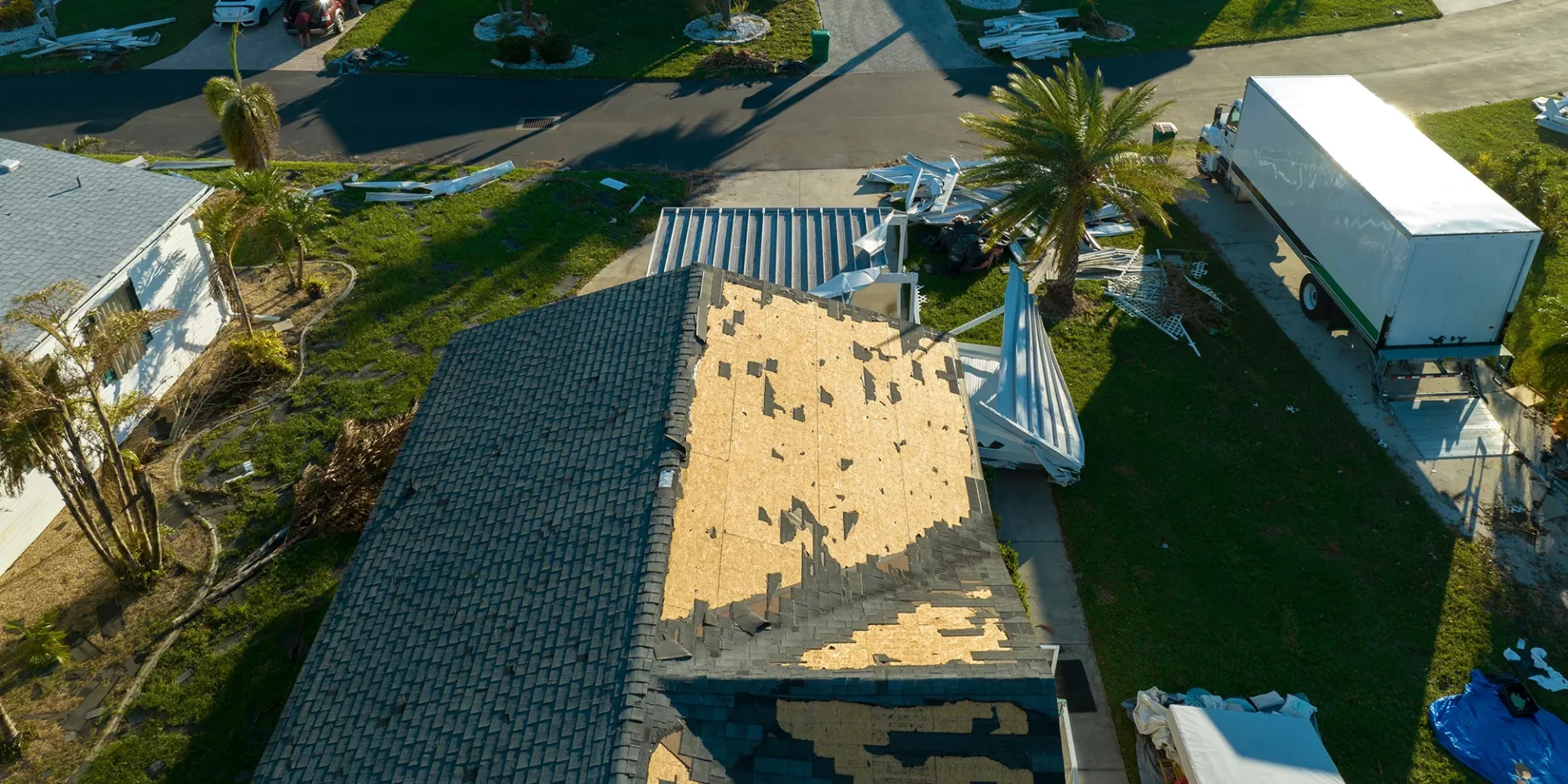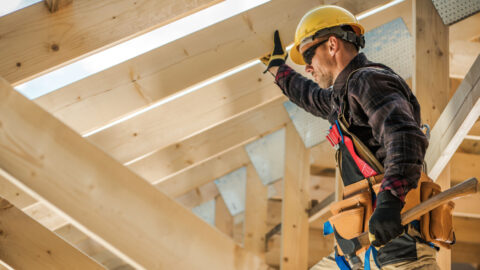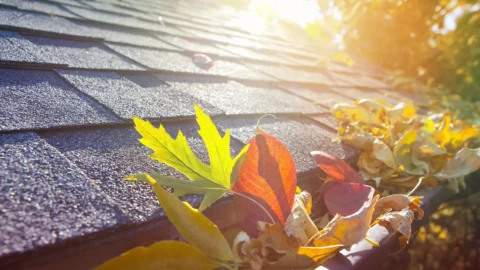Unveiling the Mystery of Roof Replacement Insurance Claims
The ins and outs of insurance can be confusing, especially when it comes to essential home repairs like roof replacement. When your home’s main layer of protection is at stake, understanding how insurance claims work is incredibly important.
We’re John Hogan Roofing, and we’ve been your local roofing experts for more than 25 years. And today, we’re going to walk you through the ins and outs of getting insurance to pay for your new roof. But let’s start with the basics: What are the common reasons that roofs need replacing in the first place?
Why Might You Need a Roof Replacement?

Roof replacement is a significant decision and often represents a major investment for homeowners. Understanding the reasons behind such a decision is essential, not only for insurance claims but also for protecting your roof. Let’s delve deeper into the most common reasons homeowners may find themselves considering a roof replacement:
- Natural Wear and Tear: Over time, every roof will face the inevitable effects of aging. Exposure to the elements, changing temperatures, and daily wear can take a toll. Typically, asphalt shingle roofs last 20-25 years, so if your roof is approaching this age or older, it might be time for a replacement.
- Damage from Storms or Falling Debris: Extreme weather events, such as hurricanes, tornadoes, and severe storms, can cause immediate and visible damage. This might include torn shingles, punctures, or dents from fallen tree branches. Sometimes, the damage could be subtle and not immediately visible, making it crucial to have regular inspections after major weather events.
- Roofing Material Deterioration: The roofing material itself can degrade, especially if it’s exposed to consistent sunlight, heavy rainfall, or if it frequently pools water. Signs of deterioration might include curling or buckling shingles, loss of granules, or areas of visible wear.
- Improper Roof Installation: Unfortunately, not all roofs are installed with the same level of expertise. If the original roof installation was done hurriedly or without adhering to industry best practices, issues might arise sooner than expected. This can include poor shingle alignment, inadequate ventilation, or incorrect flashing installation.
- Underlying Structural Issues: Sometimes the problem isn’t just with the outer roofing materials but with the underlying structures. Issues like rotting wood, sagging roof decks, or moisture damage can make a roof replacement necessary.
Understanding the root cause of your roof’s damage is not only pivotal when filing insurance claims but also ensures that the same issues don’t recur with your new roof. Regular inspections and timely interventions can prolong the life of your roof, but recognizing when it’s time for a complete replacement is essential for the safety and integrity of your home.
Decoding Roof Repair and Roof Replacement Insurance Claims
Navigating the intricate world of insurance claims for roofs can be a maze of complexity, riddled with nuances and specific stipulations. If you’re wondering about the differences between claims for roof repair and roof replacements, you’re not alone. The distinction is not only vital for your pocket but also for the overall longevity and health of your roof. Let’s delve deeper:
-
Nature of Damage:
- Roof Repair Claims: These typically cater to localized damages. This might be a small section of shingles removed by high winds or a minor leak.
- Roof Replacement Claims: These are more extensive, often arising when the majority of the roof is damaged beyond simple repair, such as substantial damage from a hurricane or a tree falling onto your roof.
-
Cost Implications:
- Roof Repair Claims: Generally less expensive since they address specific, limited areas. Insurance might cover these costs if they are due to covered events.
- Roof Replacement Claims: Significantly costlier as they involve a complete overhaul. Insurance may cover these if the damage results from a covered peril and not due to the natural end of a roof’s lifespan.
-
Deductibles and Premiums:
Depending on your policy, you may have a deductible to pay before the insurance covers the rest. A significant claim, like a roof replacement, might also influence your future insurance premiums, while minor repair claims might not have such an impact.
-
Age and Maintenance of the Roof:
Insurers often consider the age of the roof and its maintenance history. A well-maintained roof that’s relatively young might have better coverage options compared to an older roof showing signs of neglect.
-
Policy Specifics:
Every insurance policy varies. Some offer actual cash value (which accounts for depreciation), while others provide replacement costs. It’s imperative to understand these distinctions:
- Actual Cash Value: If your policy is based on ACV, it will consider the roof’s age and condition before the damage. An older roof might get you less compensation due to depreciation.
- Replacement Cost: Such policies cover the costs to replace the damaged roof without accounting for depreciation. However, premiums for these policies might be higher.
-
Exclusions:
Notably, while sudden damages from unforeseen events are generally covered, gradual wear and tear due to age or neglect aren’t. For example, if an inspection reveals that damages were due to homeowner neglect like not cleaning the gutters leading to water damage, the claim could be denied. That’s why it’s important to file claims as shortly after the damage happens as possible since it’ll be easier to find local articles proving that a storm recently moved through your area.
The fine print of your insurance policy plays a crucial role in determining your coverage. Engaging with your insurer and having regular roof inspections can aid in ensuring that you’re adequately covered and prepared, should the need for repairs or replacement arise.
Insurance and Roofing Material Costs
It’s essential to understand the type of materials used on your roof. The cost of roofing materials can vary significantly. Your insurance claim may address these costs differently based on the material’s value, lifespan, and warranty. Are premium materials like slate or metal roofing treated differently than asphalt shingles in insurance claims? Often, the answer is yes.
Getting Insurance to Pay: Frequently Asked Questions

How do I know if my damage qualifies for an insurance claim?
Before filing a claim, you should check your policy documents. If you can’t find them or they’re overly confusing, it’s always a good idea to get in touch with your insurance provider to discuss your options.
How can I ensure a smooth claim process for roof replacement or repair?
- Documentation is Key. Take clear photos of the damage, preferably from different angles.
- Stay Updated on Your Policy. Familiarize yourself with what your insurance policy covers.
- Seek Professional Assistance. Consider hiring a roofing contractor familiar with the insurance claims process.
Roof Installation: The Importance of Choosing the Right Professionals
In the Sunshine State of Florida, where the weather varies from serene sunsets to fierce hurricanes, the quality of your roof installation plays a pivotal role in your home’s safety and longevity. The process is more than just placing shingles; it’s a science that, when executed correctly, offers protection against the harshest of elements. Here’s why picking the right professionals for the job is non-negotiable:
-
Expertise in Local Conditions:
Florida’s unique weather demands specific expertise. Professionals familiar with local conditions will understand the best materials and techniques to withstand Florida’s heat, humidity, salt air, and storm potential.
-
Thorough Site Assessment:
Before the actual installation begins, a seasoned roofing expert will evaluate your site, studying factors like drainage patterns, sun exposure, and potential for wind damage. This assessment ensures that the final installation is tailored to your home’s specific needs.
-
Precision and Attention to Detail:
Quality installation goes beyond the surface. Proper sealing, ensuring adequate ventilation, and meticulous alignment are crucial components. Skilled professionals pay keen attention to these details, reducing the risk of leaks, warping, or other structural issues.
-
Material Mastery:
While there’s a vast array of roofing materials available, not all are suitable for every home or environment. Experienced roofers will guide homeowners in choosing materials that offer durability, aesthetic appeal, and cost-effectiveness, tailored to Florida’s climatic challenges.
-
Safety and Compliance:
Adhering to safety standards is non-negotiable. Established roofing professionals will ensure that the installation process abides by local building codes, manufacturer guidelines, and safety protocols. This not only safeguards the inhabitants but can also influence the home’s insurance premiums and overall value.
-
Warranties:
Reputable roofing professionals often offer warranties on their workmanship. This provides homeowners with peace of mind, knowing that in the rare event of an installation-related issue, corrections will be made without additional costs.
-
Cost Savings in the Long Run:
While opting for seasoned professionals might seem more expensive initially, the long-term savings are substantial. A well-installed roof reduces energy costs, minimizes repair expenses, and extends the roof’s lifespan, providing unparalleled value over time.
In essence, while the roofing materials play a critical role, the hands that install them are equally vital. Especially in Florida, where the elements test the mettle of every structure, entrusting your roof installation to seasoned professionals can be the difference between a fortress of safety and a looming liability.
John Hogan Roofing: Florida’s Trusted Experts in Roofing
When it comes to navigating the intricacies of roof replacement, repair, and insurance claims in Florida, John Hogan Roofing stands unmatched. With a firm grounding in the Sunshine State’s residential roofing requirements, we provide expert advice, high-quality materials, and superior installation services. Our experience with insurance claims ensures homeowners are well-equipped to navigate the often-confusing process of securing the coverage they deserve.
Roof replacements and insurance claims can seem daunting. Still, with the right knowledge and a trusted partner like John Hogan Roofing by your side, homeowners can navigate the process with confidence and peace of mind.
Roof Replacement and Insurance Claims – Video
HAVE THE WORK COMPLETED RIGHT THE FIRST TIME
You May Also Like:
Benefits of Integrating Solar Panels with Your Roof in Florida
In the Sunshine State, it’s no secret that the sun shines bright nearly all year long. Florida is not only a paradise for beach lovers but also an ideal location for harnessing solar energy. If you’re a homeowner in Florida, you’ve probably considered integrating solar panels into your home, especially as the state continues to…
Read More15 Crucial Questions to Ask Before Hiring a Roofing Contractor in Florida
15 Crucial Questions to Ask Before Hiring a Roofing Contractor in Florida (And Why They Matter) In Florida, where hurricanes, heavy rain, and intense sunshine are part of everyday life, your roof is more than just a cover — it’s your home’s first line of defense. So, when it comes time for a roof repair…
Read MorePreventative Roof Maintenance Tips for Hurricane Season in Florida
Florida’s hurricane season runs from June 1 to November 30, bringing high winds, heavy rains, and potential roof damage. Your roof is the first line of defense against these extreme weather conditions. Even minor vulnerabilities can lead to costly damage during a storm without proper maintenance. This guide provides essential preventative roof maintenance tips to…
Read More



